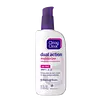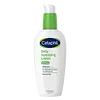What's inside
What's inside
 Key Ingredients
Key Ingredients

No key ingredients
 Benefits
Benefits

 Concerns
Concerns

No concerns
 Ingredients Side-by-side
Ingredients Side-by-side

Water
Skin ConditioningPropylene Glycol
HumectantC12-15 Alkyl Benzoate
AntimicrobialCetyl Alcohol
EmollientCyclomethicone
EmollientStearyl Alcohol
EmollientMenthyl Lactate
MaskingPropylene Glycol Isostearate
Skin ConditioningStearic Acid
CleansingGlyceryl Stearate
EmollientSalicylic Acid
MaskingPEG-100 Stearate
Sodium Hydroxide
BufferingDimethicone
EmollientSodium Isostearoyl Lactylate
EmulsifyingAcrylates/C10-30 Alkyl Acrylate Crosspolymer
Emulsion StabilisingCarbomer
Emulsion StabilisingDisodium EDTA
Phenoxyethanol
PreservativeMethylparaben
PreservativeEthylparaben
PreservativePropylparaben
PreservativeButylparaben
MaskingIsobutylparaben
AntimicrobialWater, Propylene Glycol, C12-15 Alkyl Benzoate, Cetyl Alcohol, Cyclomethicone, Stearyl Alcohol, Menthyl Lactate, Propylene Glycol Isostearate, Stearic Acid, Glyceryl Stearate, Salicylic Acid, PEG-100 Stearate, Sodium Hydroxide, Dimethicone, Sodium Isostearoyl Lactylate, Acrylates/C10-30 Alkyl Acrylate Crosspolymer, Carbomer, Disodium EDTA, Phenoxyethanol, Methylparaben, Ethylparaben, Propylparaben, Butylparaben, Isobutylparaben
Water
Skin ConditioningDicaprylyl Carbonate
EmollientHydroxyethyl Urea
HumectantCyclopentasiloxane
EmollientGlycerin
HumectantGlyceryl Stearate
EmollientPEG-100 Stearate
Hydrolyzed Hyaluronic Acid
HumectantSodium Hydroxide
BufferingHomarine Hcl
Skin ConditioningSodium PCA
HumectantCetyl Alcohol
EmollientCaprylyl Glycol
EmollientPhenoxyethanol
PreservativeAcrylates/C10-30 Alkyl Acrylate Crosspolymer
Emulsion StabilisingErythritol
Humectant
 Reviews
Reviews

Ingredients Explained
These ingredients are found in both products.
Ingredients higher up in an ingredient list are typically present in a larger amount.
Acrylates/C10-30 Alkyl Acrylate Crosspolymer is a synthetic polymer. It is used to thicken and improve the texture of products. Due to its properties, it can prevent water and oil ingredients from separating.
Cetyl Alcohol is a fatty alcohol. Fatty Alcohols are most often used as an emollient or to thicken a product.
Its main roles are:
Though it has "alcohol" in the name, it is not related to denatured alcohol or ethyl alcohol.
The FDA allows products labeled "alcohol-free" to have fatty alcohols.
Learn more about Cetyl AlcoholGlyceryl Stearate is a mix of glycerin and stearic acid.
It is used to stabilize the mixing of water and oil ingredients. By preventing these ingredients from separating, it can help elongate shelf life. It can also help thicken the product's texture.
As an emollient, it helps soften skin and supports barrier-replenishing ingredients.
In cosmetics, Glyceryl Stearate is often made from vegetable oils or synthetically produced.
This ingredient may not be fungal-acne safe
Fun fact: The human body also creates Glyceryl Stearate naturally.
Learn more about Glyceryl StearatePeg-100 Stearate is an emollient and emulsifier. As an emollient, it helps keep skin soft by trapping moisture in. On the other hand, emulsifiers help prevent oil and water from separating in a product.
PEGS are a hydrophilic polyether compound . There are 100 ethylene oxide monomers in Peg-100 Stearate. Peg-100 Stearate is polyethylene glycol ester of stearic acid.
Phenoxyethanol is a preservative that has germicide, antimicrobial, and aromatic properties. Studies show that phenoxyethanol can prevent microbial growth. By itself, it has a scent that is similar to that of a rose.
It's often used in formulations along with Caprylyl Glycol to preserve the shelf life of products.
Sodium Hydroxide is also known as lye or caustic soda. It is used to adjust the pH of products; many ingredients require a specific pH to be effective.
In small amounts, sodium hydroxide is considered safe to use. However, large amounts may cause chemical burns due to its high alkaline.
Your skin has a natural pH and acid mantle. This acid mantle helps prevent harmful bacteria from breaking through. The acid mantle also helps keep your skin hydrated.
"Alkaline" refers to a high pH level. A low pH level would be considered acidic.
Learn more about Sodium HydroxideWater. It's the most common cosmetic ingredient of all. You'll usually see it at the top of ingredient lists, meaning that it makes up the largest part of the product.
So why is it so popular? Water most often acts as a solvent - this means that it helps dissolve other ingredients into the formulation.
You'll also recognize water as that liquid we all need to stay alive. If you see this, drink a glass of water. Stay hydrated!
Learn more about Water